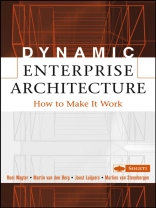This book presents an approach to enterprise architecture, which enables corporations to achieve their business objectives faster. Focusing on the governance of IT in the organization, it provides tangible tools, advice and strategies for implementing and designing the architectural process within a corporation that will make a major contribution in driving the business forward and achieve its goals.
Inhaltsverzeichnis
Preface.
Introduction.
Target Audience.
The Structure of This Book.
Chapter 1: Agility and Coherence: A Conflict of
Interests?
Potential of Information Technology.
Using IT: A Problem in the Making?
Agility and Coherence.
Increasing Tension.
The Challenge.
Chapter 2: Agility and Coherence Considered
Separately.
Different Answers to Different Questions.
Increasing Agility: New Development Methods.
Increasing Coherence: Architectural Awareness.
One Answer to Both Questions: Dynamic Architecture.
Chapter 3: Dynamic Architecture.
Wanted: Agile Architecture.
Architecture: A Multifaceted Concept.
Dynamic Architecture: Architecture Aimed at Agility.
Enabling Change.
Quickly Achieving Business Objectives: DYA.
Chapter 4: The DYA Model.
Making It Work.
Ten Principles of DYA.
DYA: A Theoretical and Working Model.
The Model and the Principles.
How to Use the Model.
Filling in the Model.
Chapter 5: Strategic Dialogue.
Crisis at WWW-Tele Bel.
Strategic Dialogue: Doing the Right Things.
Determining Business Cases.
Elaborating Business Cases.
Strategic Dialogue: Coherence and Agility.
Intermezzo: The Business Case for WWW-Tele Bel.
Chapter 6: Architectural Services.
Architectural Ups and Downs at Tele Bel.
Architectural Services: Doing Things Properly.
Maintaining an Overview with the Architectural Framework.
Architectural Services Supports the Strategic Dialogue.
Architectural Services Supports the Development.
Architectural Team.
Architectural Services: Coherence and Agility.
Intermezzo: WWW-Tele Belâ??s Project-Start Architecture.
Chapter 7: Development with(out) Architecture.
WWW-Tele Bel One Year Later.
Development with(out) Architecture: Doing the Right Things the
Right Way.
Three Development Strategies.
Anticipative Strategy.
Offensive Strategy and Defensive Strategy.
Project Team.
Maintenance with(out) Architecture.
Development with(out) Architecture: Coherence and Agility.
Intermezzo I: A Building Permit for WWW-Tele Bel.
Intermezzo II: A Management Letter for WWW-Tele Bel.
Chapter 8: Governance.
Deadlock for Tele Bel.
Successful Processes Do Not Just Happen.
Responsibilities and Authorities.
Coordination of Developments.
Monitoring.
Processes Also Require Maintenance.
Governance: Coherence and Agility.
Intermezzo: Embedding Dynamic Architecture at Tele Bel.
Conclusion.
Appendices.
Appendix A: Technique for Interactive Process Design.
Appendix B: Information Economics.
Appendix C: Architecture Maturity Model and Dynamic
Architecture.
Glossary.
Bibliography.
Index.
Über den Autor
ROEL WAGTER is Chairman of R. Wagter Business and ICT Architecture
B.V. and has more than thirty years of experience in the
information technology field. He has held numerous managerial
positions in which he gained experience in the alignment between
business and IT. These experiences are the foundation for his ideas
on enterprise architecture.
MARTIN van den BERG is Chairman of the architecture section of
the Dutch Society of IT Professionals, and an enterprise architect
and service line manager with Sogeti Nederland B.V. He advises and
trains companies in applying enterprise and IT architectures. In
addition, he develops services to support organizations to improve
the way they work with enterprise and IT architecture.
JOOST LUIJPERS is an information architect with Sogeti Nederland
B.V. Prior to joining Sogeti, he was a professor of information
engineering.
MARLIES van STEENBERGEN has more than ten years of experience as
an enterprise architect. She now works for Sogeti Nederland B.V. as
an advisor and coach in the field of enterprise architecture, and
chairs Sogeti’s Architectural Competence Network.












